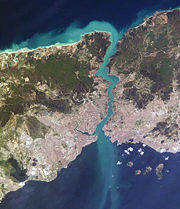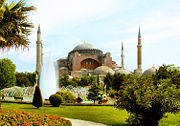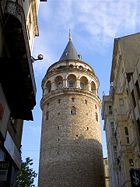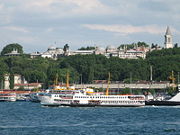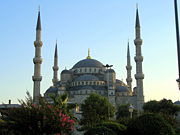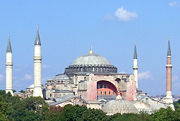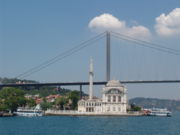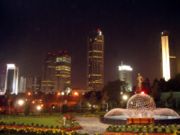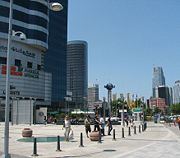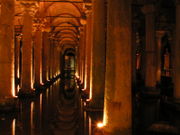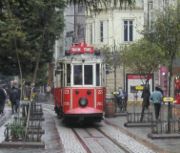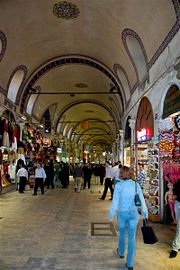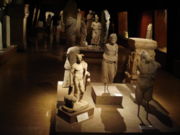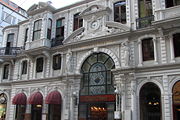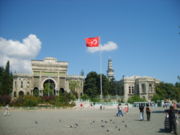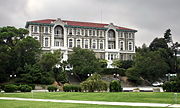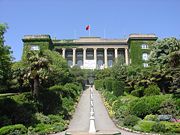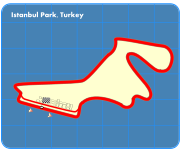Istanbul
2008/9 Schools Wikipedia Selection. Related subjects: Europe; European Cities
| Istanbul | |||
 |
|||
|
|||
| Location of Istanbul on the Bosphorus Strait, Turkey | |||
| Coordinates: | |||
|---|---|---|---|
| Country | |||
| Region | Marmara | ||
| Province | Istanbul | ||
| Founded | 667 BC as Byzantium | ||
| Roman/Byzantine period | AD 330 as Nova Roma (original name given in 330 and used during Constantine's reign) and later Constantinople (following Constantine's death in 337) | ||
| Ottoman period | 1453 as Konstantiniyye (in Ottoman Turkish), Constantinople (internationally) and various other names in local languages | ||
| Turkish Republic period | 1923 as Istanbul (in Turkish) and Constantinople (internationally), renamed as Istanbul also in foreign languages following the Turkish Postal Service Law of March 28, 1930 | ||
| Districts | 27 | ||
| Area | |||
| - Total | 1,830.92 km² (706.9 sq mi) | ||
| Elevation | 100 m (328 ft) | ||
| Population (2007) | |||
| - Total | 11,372,613 ( 3rd) | ||
| - Density | 6,211/km² (16,086.4/sq mi) | ||
| Time zone | EET ( UTC+2) | ||
| - Summer ( DST) | EEST ( UTC+3) | ||
| Postal code | 34010 to 34850 and 80000 to 81800 |
||
| Area code(s) | (+90) 212 (European side) (+90) 216 (Asian side) |
||
| Licence plate | 34 | ||
| Website: Istanbul Portal | |||
| Historic Areas of Istanbul* | |
|---|---|
| UNESCO World Heritage Site | |
| State Party | |
| Type | Cultural |
| Criteria | I, II, III, IV |
| Reference | 356 |
| Region** | Europe and North America |
| Inscription history | |
| Inscription | 1985 (9th Session) |
| * Name as inscribed on World Heritage List. ** Region as classified by UNESCO. |
|
Istanbul (historically Byzantium and later Constantinople; see the other names of Istanbul) is Europe's most populous city ( the world's 3rd largest city proper and 21st largest urban area) and Turkey's cultural and financial centre. The city covers 27 districts of the Istanbul province. It is located on the Bosphorus Strait and encompasses the natural harbour known as the Golden Horn, in the northwest of the country. It extends both on the European ( Thrace) and on the Asian ( Anatolia) side of the Bosphorus, and is thereby the only metropolis in the world which is situated on two continents. In its long history, Istanbul served as the capital city of the Roman Empire (330–395), the East Roman (Byzantine) Empire (395–1204 and 1261–1453), the Latin Empire (1204–1261), and the Ottoman Empire (1453–1922). The city was chosen as joint European Capital of Culture for 2010. The historic areas of Istanbul were added to the UNESCO World Heritage List in 1985.
Names
The modern Turkish name İstanbul ( IPA: [isˈtanbul] or colloquial [ɨsˈtanbul]) can be attested, in a range of different variants, from as far back as the 10th century; it has been the common name for the city in normal Turkish speech since before the conquest of 1453. Etymologically, it derives from the Greek phrase "εἰς τὴν Πόλιν" [istimˈbolin] or in the Aegean dialect "εἰς τὰν Πόλιν" [istamˈbolin] (modern Greek "στην Πόλι" [stimˈboli]), which means "in the city", "to the city" or "downtown".
Byzantium is the first known name of the city. When Roman emperor Constantine I (Constantine the Great) made the city the new eastern capital of the Roman Empire on May 11, 330, he conferred on it the name Nova Roma ("New Rome"). Constantinople ("City of Constantine") was the name by which the city became instead more widely known. It is first attested in official use under emperor Theodosius II (408–450). It remained the principal official name of the city throughout the Byzantine period, and the most common name used for it in the West until the early 20th century.
The city has also been nicknamed " The City on Seven Hills" because the historic peninsula, the oldest part of the city, was built on seven hills (just like Rome), each of which bears a historic mosque. The hills are represented in the city's emblem with seven triangles, above which rise four minarets. Two of many other old nicknames of Istanbul are Vasilevousa Polis (the Queen of Cities), which rose from the city's importance and wealth throughout the Middle Ages; and Dersaadet, originally Der-i Saadet (the Door to Happiness) which was first used towards the end of 19th century and is still remembered today.
With the Turkish Postal Service Law of March 28, 1930, the Turkish authorities officially requested foreigners to adopt Istanbul as the sole name also in their own languages.
History
| “ | If the Earth were a single state, Istanbul would be its capital. | ” |
The first human settlement in Istanbul, the Fikirtepe mound on the Anatolian side, is from the Copper Age period, with artifacts dating from 5500–3500 BC. A port settlement dating back to the Phoenicians has been discovered in nearby Kadıköy ( Chalcedon). Cape Moda in Chalcedon was the first location which the Greek settlers of Megara chose to colonize in 685 BC, prior to colonising Byzantion on the European side of the Bosphorus under the command of King Byzas in 667 BC. Byzantion was established on the site of an ancient port settlement named Lygos, founded by Thracian tribes between the 13th and 11th centuries BC, along with the neighbouring Semistra, of which Plinius had mentioned in his historical accounts. Only a few walls and substructures belonging to Lygos have survived to date, near the Seraglio Point ( Turkish: Sarayburnu), where the famous Topkapı Palace now stands. During the period of Byzantion, the Acropolis used to stand where the Topkapı Palace stands today.
After siding with Pescennius Niger against the victorious Roman emperor Septimius Severus, the city was besieged by the Romans and suffered extensive damage in 196 AD. Byzantium was rebuilt by Severus and quickly regained its previous prosperity, being temporarily renamed as Augusta Antonina by the emperor, in honour of his son.
The location of Byzantium attracted Constantine I in 324 after a prophetic dream was said to have identified the location of the city; but the true reason behind this prophecy was probably Constantine's final victory over Licinius at the Battle of Chrysopolis ( Üsküdar) on the Bosphorus, on September 18, 324, which ended the civil war between the Roman Co-Emperors, and brought an end to the final vestiges of the Tetrarchy system, during which Nicomedia (present-day İzmit, 100 km (62 mi) east of Istanbul) was the most senior Roman capital city. Byzantium (now renamed as Nova Roma which eventually became Constantinopolis, i.e. "The City of Constantine") was officially proclaimed the new capital of the Roman Empire six years later, in 330. Following the death of Theodosius I in 395 and the permanent partition of the Roman Empire between his two sons, Constantinople became the capital of the Eastern Roman (Byzantine) Empire. As well as being the centre of an imperial dynasty, the unique position of Constantinople at the centre of two continents made the city a magnet for international commerce, culture and diplomacy. The Byzantine Empire was distinctly Greek in culture and became the centre of Greek Orthodox Christianity, while its capital was adorned with many magnificent churches, including the Hagia Sophia, once the world's largest cathedral. The seat of the Patriarch of Constantinople, spiritual leader of the Eastern Orthodox Church, still remains in the Fener (Greek: Phanar) district of Istanbul.
In 1204, the Fourth Crusade was launched to capture Jerusalem, but had instead turned on Constantinople, which was sacked and desecrated. The city subsequently became the centre of the Catholic Latin Empire, created by the crusaders to replace the Orthodox Byzantine Empire, which was divided into a number of splinter states, of which the Empire of Nicaea was to recapture Constantinople in 1261 under the command of Michael VIII Palaeologus.
In the last decades of the Byzantine Empire, the city had decayed as the Byzantine state became increasingly isolated and financially bankrupt, its population had dwindled to some thirty or forty thousand people whilst large sections remained uninhabited. Due to the ever increasing inward turn the Byzantines took, many facets of their surrounding empire were now falling apart, leaving them vulnerable to attack. Ottoman Turks began a strategy by which they took selected towns and smaller cities over time, enveloping Bursa in 1326, Nicomedia in 1337, Gallipoli in 1354, and finally Adrianople in 1362. This essentially cut off Constantinople from its main supply routes, strangling it slowly.
On May 29, 1453, Sultan Mehmed II "the Conqueror" captured Constantinople after a 53-day siege and proclaimed that the city was now the new capital of his Ottoman Empire. Sultan Mehmed's first duty was to rejuvenate the city economically, creating the Grand Bazaar and inviting the fleeing Orthodox and Catholic inhabitants to return. Captured prisoners were freed to settle in the city whilst provincial governors in Rumelia and Anatolia were ordered to send four thousand families to settle in the city, whether Muslim, Christian or Jew, to form a unique cosmopolitan society. The Sultan also endowed the city with various architectural monuments, including the Topkapı Palace and the Eyüp Sultan Mosque. Religious foundations were established to fund the construction of grand imperial mosques (such as the Fatih Mosque which was built on the spot where the Church of the Holy Apostles once stood), adjoined by their associated schools, hospitals and public baths. Suleiman the Magnificent's reign of the Ottoman Empire from 1520 to 1566 was a period of great artistic and architectural achievements. The famous architect Sinan designed many mosques and other grand buildings in the city, while Ottoman arts of ceramics and calligraphy also flourished.
When the Republic of Turkey was founded in 1923 by Mustafa Kemal Atatürk, the capital was moved from Istanbul to Ankara. In the early years of the republic, Istanbul was overlooked in favour of the new capital Ankara. However, in the 1950s, Istanbul underwent great structural change, as new roads and factories were constructed throughout the city. Wide modern boulevards, avenues and public squares were built in Istanbul, sometimes at the expense of the demolition of many historical buildings. During the 1970s, the population of Istanbul began to rapidly increase as people from Anatolia migrated to the city in order to find employment in the many new factories that were constructed at the outskirts of the city. This sudden sharp increase in the population caused a rapid rise in housing development, and many previously outlying villages became engulfed into the greater metropolis of Istanbul. Illegal construction, combined with corner-cutting methods, have accounted for the reason why 65% of all of the buildings in Istanbul are not up to standard. The concerns have increased due to the serious nature of the Izmit earthquake of 1999.
Geography
Istanbul is located in the north-west Marmara Region of Turkey. It encloses the southern Bosphorus which places the city on two continents—the western portion of Istanbul is in Europe, while the eastern portion is in Asia. The city boundaries cover a surface area of 1,539 square kilometres (594 sq mi), while the metropolitan region, or the Province of Istanbul, covers 6,220 square kilometres (2,402 sq mi).
Climate
The city has a Mediterranean climate with hot and humid summers; and cool, rainy and often snowy winters. Humidity is generally rather high which can make temperatures feel much warmer or colder than they actually are. Yearly precipitation for Istanbul averages 640 millimetres (25.2 in). Snowfall is quite common, snowing for a week or two during the winter season, but it can be heavy once it snows. It is most likely to occur between the months of December and March. The summer months between June and September bring average daytime temperatures of 28 °C (82 °F). The warmest month is July with an average temperature of 23.3 °C (74 °F), the coldest is January with 5.6 °C (42 °F). The weather becomes slightly cooler as one moves toward eastern Istanbul. Summer is by far the driest season, although there is no real summer drought such as those occurring at Mediterranean climates or in the arid interior of Turkey. The city is quite windy, having an average wind speed of 17 km/h (11 mph).
| Weather averages for Istanbul | |||||||||||||
|---|---|---|---|---|---|---|---|---|---|---|---|---|---|
| Month | Jan | Feb | Mar | Apr | May | Jun | Jul | Aug | Sep | Oct | Nov | Dec | Year |
| Average high °C | 8 | 8 | 11 | 16 | 21 | 26 | 28 | 28 | 24 | 19 | 14 | 10 | 18 |
| Average low °C | 3 | 3 | 4 | 8 | 12 | 17 | 19 | 19 | 16 | 13 | 8 | 6 | 11 |
| Precipitation mm | 94 | 71.1 | 58.4 | 43.2 | 30.5 | 22.9 | 17.8 | 15.2 | 27.9 | 53.3 | 88.9 | 101.6 | 640.1 |
| Average high °F | 46 | 47 | 51 | 60 | 69 | 78 | 82 | 82 | 76 | 67 | 57 | 50 | 64 |
| Average low °F | 37 | 37 | 40 | 47 | 54 | 62 | 66 | 67 | 61 | 55 | 47 | 42 | 51 |
| Precipitation inches | 3.7 | 2.8 | 2.3 | 1.7 | 1.2 | 0.9 | 0.7 | 0.6 | 1.1 | 2.1 | 3.5 | 4.0 | 25.2 |
| Source: Weatherbase 2008-01-04 | |||||||||||||
Geology
Istanbul is situated near the North Anatolian fault line, which runs from northern Anatolia to the Marmara Sea. Two tectonic plates, the African and the Eurasian, push against each other here. This fault line has been responsible for several deadly earthquakes in the region throughout history. In 1509 a catastrophic earthquake caused a tsunami which broke over the sea-walls of the city, destroying over 100 mosques and killing 10,000 people. In 1766 the Eyüp Sultan Mosque was largely destroyed. The 1894 earthquake caused the collapse of many parts of the Grand Bazaar. A devastating earthquake in August 1999, with its epicenter in nearby Kocaeli, left 18,000 dead and many more homeless. In all of these earthquakes, the devastating effects are a result of the close settlement and poor construction of buildings. Seismologists predict another earthquake, possibly measuring magnitude 7.0, occurring before 2025.
Architecture
Throughout its long history, Istanbul has acquired a reputation for being a cultural and ethnic melting pot. As a result, there are many historical mosques, churches, synagogues, palaces, castles and towers to visit in the city. Some of these historical structures, which draw millions to the city every year, reflect the heart and soul of Istanbul.
The famous Maiden's (Leander's) Tower, one of the symbols of Istanbul, was originally built by the ancient Athenian general Alcibiades in 408 BC to control the movements of the Persian ships in the Bosphorus strait. Back then it was located between the cities of Byzantion and Chrysopolis. The tower was later enlarged and rebuilt as a fortress by the Byzantine emperor Alexius Comnenus in 1110, and was rebuilt and restored several times by the Ottoman Turks, most significantly in 1509 and 1763.
The most important monuments of Roman architecture in the city include the Column of Constantine ( Turkish: Çemberlitaş), which was erected in 330 by Constantine the Great for marking the declaration of the new capital city of the Roman Empire and contained several fragments of the True Cross and other artifacts belonging to Jesus Christ and Virgin Mary, the Mazulkemer Aqueduct, the Valens Aqueduct, the Column of the Goths at the Seraglio Point, the Milion which served for calculating the distances between Constantinople and other cities of the Roman Empire, and the Hippodrome of Constantinople which was built following the model of the Circus Maximus in Rome. Construction of the Walls of Constantinople began under Constantine the Great, who enlarged the previously existing walls of Byzantium in order to defend the new Roman capital city which quickly grew following its proclamation as Nova Roma. A new set of walls was built further west during the reign of Theodosius II, and rebuilt after an earthquake in 447 in their current shape.
The early Byzantine architecture followed the classical Roman model of domes and arches, but further improved these architectural concepts, as evidenced with the Hagia Sophia, which is the largest structure on Sultanahmet Square in the Eminönü district. The Hagia Sophia was designed by Isidorus and Anthemius as the third church to rise on this location, between 532 and 537, following the Nika riots (532) during which the second church was destroyed (the first church, known as the Megala Ekklessia ("Great Church") was inaugurated by Constantius II in 360; the second church was inaugurated by Theodosius II in 405, while the third and current one was inaugurated by Justinian in 537). The Church of Saints Sergius and Bacchus (commonly known as the Little Hagia Sophia), which was the first church built by Justinian in Constantinople and edificed between 527 and 536, had earlier signaled such an improvement in the design of domed buildings, which require complex solutions for carrying the structure. The present-day Hagia Irene (which was originally built by Constantine in the 4th century, but was later enlarged by Justinian in the 6th century) and the Basilica Cistern are also from this period.
The most important churches which were built after the Byzantines recovered Constantinople from the Latin Crusaders in 1261 include the Pammakaristos Church and Chora Church. Also in this period, the Genoese Podestà of Galata, Montano de Marinis, built the Palazzo del Comune (1314), a copy of the San Giorgio Palace in Genoa, which still stands in ruins on the back streets of Bankalar Caddesi in Galata, together with its adjacent buildings and numerous Genoese houses from the early 1300s. The Genoese also built the Galata Tower, which they named as Christea Turris (Tower of Christ), at the highest point of the citadel of Galata, in 1348.
The Ottoman Turks built the Anadoluhisarı on the Asian side of the Bosphorus in 1394, and the Rumelihisarı at the opposite (European) shore, in 1452, a year before the conquest of Constantinople. The main purpose of these castles, armed with the long range Balyemez (Faule Metze) cannons, was to block the sea traffic of the Bosphorus and prevent the support ships from the Genoese colonies on the Black Sea ports, such as Caffa, Sinop, and Amasra, from reaching Constantinople and helping the Byzantines during the Turkish siege of the city.
Following the Ottoman conquest of the city, Sultan Mehmed II initiated a wide scale reconstruction plan, which included the construction of grand buildings such as the Eyüp Sultan Mosque, Fatih Mosque, Topkapı Palace, the Grand Bazaar and the Yedikule (Seven Towers) Castle which guarded the main entrance gate of the city, the Porta Aurea (Golden Gate). In the centuries following Mehmed II, many new important buildings, such as the Süleymaniye Mosque, Sultanahmet Mosque, Yeni Mosque and numerous others were constructed. In the 18th and 19th centuries, traditional Ottoman architectural styles were gradually replaced by European styles, such as the Baroque style interiors of the Aynalıkavak Palace (1677–1679) and Nuruosmaniye Mosque (1748–1755, the first Baroque style mosque in the city, also famous for its Baroque fountain), and the 18th century Baroque additions to the Harem section of the Topkapı Palace. Following the Tanzimat reforms which effectively started Turkey's Europeanization process in 1839, new palaces and mosques were built in Neoclassical, Baroque and Rococo styles, or a mixture of all three, such as the Dolmabahçe Palace, Beylerbeyi Palace and Ortaköy (Mecidiye) Mosque.
Starting from the early 19th century, the areas around İstiklal Avenue were filled with grandiose embassy buildings belonging to prominent European states, and rows of European (mostly Neoclassical and later Art Nouveau) style buildings started to appear on both flanks of the avenue. Istanbul especially became a major centre of the Art Nouveau movement in the late 19th and early 20th centuries, with famous architects of this style like Raimondo D'Aronco building many palaces and mansions in the city proper and on the Princes' Islands. His most important works in the city include several buildings of the Yıldız Palace complex, and the Botter House on İstiklal Avenue. The famous Camondo Stairs on Bankalar Caddesi (Banks Street) in Karaköy ( Galata) is also a beautiful example of Art Nouveau architecture. Other important examples are the Hıdiv Kasrı (Khedive Palace) on the Asian side of the Bosphorus, Flora Han in Sirkeci, and Frej Apartmanı in the Şişhane quarter of Beyoğlu.
Urbanism
|
|
|
|
The urban landscape is constantly changing. In the Greek, Roman and Byzantine periods, the city was largely made up of the historic peninsula of Constantinople, with the citadel of Galata (also called Sykae or Pera) at north, and Chrysopolis ( Üsküdar) and Chalcedon ( Kadıköy) at east, across the Bosphorus. These were all independent cities back then. The present City of Istanbul can be considered the metropolitan area of old Constantinople, encompassing every single settlement around the original city, and expanding even further with the establishment of new neighbourhoods and districts since the 19th century.
Until the early 19th century, the city walls of Galata, the medieval Genoese citadel, used to stand. These Genoese fortifications, of which only the Galata Tower stands today, were demolished in the early 1800s to give way for a northwards expansion of the city, towards the neighbourhoods of Beşiktaş, Şişli, Nişantaşı, and beyond.
In the last decades, numerous tall structures were built around the city to accommodate a rapid growth in population. Surrounding towns were absorbed into Istanbul as the city rapidly expanded outwards. The tallest highrise office and residential buildings are mostly located in the northern areas of the European side, and especially in the business and shopping districts of Levent, Maslak, and Etiler which are situated between the Bosphorus Bridge and Fatih Sultan Mehmet Bridge. Levent and Etiler also have numerous upmarket shopping malls, like Kanyon, Metrocity, Akmerkez, Mayadrom and Mayadrom Uptown. The headquarters of Turkey's largest companies and banks are also located in this area.
Starting from the second half of the 20th century, the Asian side of Istanbul, which was originally a tranquil place full of seaside summer residences and elegant chalet mansions surrounded by lush and vast umbrella pine gardens, experienced a massive urban growth. The construction of the long, wide and elegant Bağdat Avenue, with its rows of upscale shops and restaurants, contributed much to the initial expansion in the area. The fact that these areas were largely empty until the 1960s also provided the chance for developing better infrastructure and a tidier urban planning when compared with most other residential areas in the city. But the real expansion of the Asian side came with the opening of Ankara Asfaltı, the Asian extension of the E5 highway, which is located to the north of Bağdat Avenue, parallel to the railway line. Another important factor in the recent growth of the Asian side of the city was migration from Anatolia. Today, more than 1/3 of the city's population live in the Asian side of Istanbul.
As a result of Istanbul's exponential growth during the second half of the 20th century, a significant portion of the city's outskirts consists of gecekondus, a Turkish word created in the 1940s meaning ‘built overnight’ and referring to the illegally constructed squatter buildings that comprise entire neighbourhoods and run rampant outside the historic centers of Turkey's largest cities, especially Istanbul, Ankara, İzmir, and Bursa. At present, some gecekondu areas are being gradually demolished and replaced by modern mass-housing compounds.
Administration
Organization
The mayor of Istanbul, currently Kadir Topbaş, serves as the prefect of the city, as well as governor of the province. Istanbul is a home rule city and municipal elections are mainly partisan. The metropolitan model of governance has been used with the establishment of metropolitan administration in 1930. The metropolitan council is responsible for all authority when it comes to making city decisions. The metropolitan government structure consists of three main organs: (1) The Metropolitan Mayor (elected every five years), (2) The Metropolitan Council (decision making body with the mayor, district Mayors, and one fifth of the district municipal councilors), (3) The metropolitan executive committee. There are three types of local authorities: (1) municipalities, (2) special provincial administrations, (3) village administrations. Among the local authorities, municipalities are gaining greater importance with the rise in urbanization.
Districts
burnu
Istanbul Province has 32 districts, of which 27 form the city proper of Istanbul, also called Greater Istanbul, administered by the Istanbul Metropolitan Municipality (or Municipality of Metropolitan Istanbul) ( Turkish: İstanbul Büyükşehir Belediyesi. These city districts, each of which forms a municipality with an elected mayor and council, can be grouped into three main areas: (1) the historic peninsula, (2) the areas north of the Golden Horn, and (3) the Asian side.
The historic peninsula of old Istanbul corresponds approximately to the extent of Constantinople in the 15th century; it comprises the districts of Eminönü and Fatih. This area lies on the southern shores of the Golden Horn, which separates the old city centre from the northern and younger parts of the European side. The historic peninsula ends with the Theodosian Land Walls in the west. The peninsula is surrounded by the Sea of Marmara on the south and the entrance of the Bosphorus on the east.
North of the Golden Horn are the historical Beyoğlu and Beşiktaş districts, where the last Sultan's palace is located, followed by a chain of former villages such as Ortaköy and Bebek along the shores of the Bosphorus. On both the European and Asian sides of the Bosphorus, wealthy Istanbulites built luxurious chalet mansions, called yalı, which were used as summer residences.
The quarters of Üsküdar ( Chrysopolis) and Kadıköy ( Chalcedon) which are located on the Asian side were originally independent cities, like Beyoğlu ( Pera) also used to be. Today they are full of modern residential areas and business districts, and are home to around one-third of Istanbul's population.
Demographics
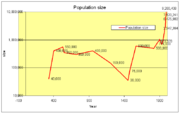
The city of Istanbul has a population of 11,372,613 residents according to the latest count as of 2007, and is one of the largest cities in Europe today. Currently Istanbul has 54 municipalities, and stretches over an area of about 65 miles (approximately 100 km). The rate of population growth in the city is currently at 3.45% a year on average, mainly due to the influx of people from the surrounding rural areas. Istanbul's population density of 2,742 people per square mile (1,700 per square km) far exceeds Turkey's 130 people per square mile (81 people per square km).
|
|
|
|
Religion
The urban landscape of Istanbul is shaped by many communities. Among all major religions that are practiced in the city, the one with the most populous community is Islam. The first mosque in Istanbul was built in Kadıköy (ancient Chalcedon) on the Asian side, in the mid 14th century; a full century before the conquest of Constantinople across the Bosporus, on the European side, by the Ottoman Turks in 1453. The first mosque on the European side of Istanbul was built inside the Rumeli Castle in 1452. The first grand mosque which was built in the city proper was the Eyüp Sultan Mosque in around 1459. The mosque was built on the site of the grave of Abu Ayyub al-Ansari, a companion of the Prophet Muhammad who had died fighting in the Arab army in a siege to take the city in 669, making Istanbul one of the holy cities of Islam. The first imperial mosque inside the city walls was the Fatih Mosque (1470) which was built on the site of the Church of the Holy Apostles, an important Byzantine church which was originally edificed in the time of Constantine the Great. Many other imperial mosques were built in the following centuries, such as the famous Süleymaniye Mosque (1557) which was ordered by Suleiman the Magnificent and designed by the great Ottoman architect Sinan, and the famous Sultan Ahmet Mosque (1616) which is also known as the Blue Mosque for the blue tiles which adorn its interior.
Istanbul was the final seat of the Islamic Caliphate, between 1517 and 1924. The personal belongings of Mohammed and the earliest Caliphs who followed him are today preserved in the Topkapı Palace, the Eyüp Sultan Mosque and in several other prominent mosques of Istanbul. The seat of the Patriarch of Constantinople, spiritual leader of the Greek Orthodox Church is located in the Fener ( Greek: Φανάρι) district. Also based in Istanbul are the archbishop of the Turkish-Orthodox community, an Armenian archbishop, and the Turkish Grand- Rabbi.
According to the 2000 census, there were 2691 active mosques, 123 active churches and 26 active synagogues in Istanbul; as well as 109 Muslim cemeteries and 57 non-Muslim cemeteries. Religious minorities include Greek Orthodox Christians, Armenian Christians, Catholic Levantines and Sephardic Jews. Some neighbourhoods have sizeable populations of these ethnic groups, such as the Kumkapı neighbourhood, which has a sizeable Armenian population, the Balat neighbourhood, which has a sizeable Jewish population, the Fener neighbourhood which has a sizeable Greek population, and some neighbourhoods in Nişantaşı and Beyoğlu, which have sizeable Levantine populations. In some quarters, such as Kuzguncuk, an Armenian church sits next to a synagogue, and on the other side of the road a Greek Orthodox church is found beside a mosque.
Economy
Historically, Istanbul has been the centre of the country's economic life because of its location as an international junction of land and sea trade routes. In 2005 the City of Istanbul had a GDP of $133 billion. In 2005 companies based in Istanbul made exports worth $41,397,000,000 and imports worth $69,883,000,000; which corresponded to 56.6% and 60.2% of Turkey's exports and imports, respectively, in that year. According to Forbes magazine, Istanbul had a total of 35 billionaires as of March 2008 (up from 25 in 2007), ranking 4th in the world behind Moscow (74 billionaires), New York City (71 billionaires) and London (36 billionaires), while ranking above Hong Kong (30 billionaires), Los Angeles (24 billionaires), Mumbai (20 billionaires), San Francisco (19 billionaires), Dallas (15 billionaires) and Tokyo (15 billionaires).
Istanbul has always been the financial capital of Turkey and the opening of specific markets in the city during the 1980s further strengthened this status. Inaugurated at the beginning of 1986, the Istanbul Stock Exchange (ISE) is the sole securities market of Turkey, established to provide trading in equities, right coupons, Government bonds, Treasury bills, revenue sharing certificates, bonds issued by the Privatization Administration and corporate bonds, and to carry out overnight transactions. In 1993 the ISE decided on gold market liberalization, and in 1995 the Istanbul Gold Exchange was established, which ended the gold bullion imports monopoly of the Turkish Central Bank and transferred it to the private sector members of the gold exchange.
Istanbul is also Turkey's largest industrial centre. It employs approximately 20% of Turkey's industrial labor and contributes 38% of Turkey's industrial workspace. In addition, the city generates 55% of Turkey's trade and 45% of the country's wholesale trade, and generates 21.2% of Turkey's gross national product. Istanbul contributes 40% of all taxes collected in Turkey and produces 27.5% of Turkey's national product. Istanbul and its surrounding province produce cotton, fruit, olive oil, silk, and tobacco. Food processing, textile production, oil products, rubber, metal ware, leather, chemicals, pharmaceuticals, electronics, glass, machinery, automotive, transport vehicles, paper and paper products, and alcoholic drinks are among the city's major industrial products.
Istanbul is one of the most important tourism spots of Turkey. There are thousands of hotels and other tourist oriented industries in the city, catering to both vacationers and visiting professionals. In 2006 a total of 23,148,669 tourists visited Turkey, most of whom entered the country through the airports and seaports of Istanbul and Antalya. The total number of tourists who entered Turkey through Atatürk International Airport and Sabiha Gökçen International Airport in Istanbul reached 5,346,658, rising from 4,849,353 in 2005. Istanbul is also one of the world's major conference destinations and is an increasingly popular choice for the world's leading international associations.
Infrastructure
Health and medicine
The city has many public and private hospitals, clinics and laboratories within its bounds and numerous medical research centers. Many of these facilities have high technology equipment, which has contributed to the recent upsurge in "medical tourism" to Istanbul, particularly from West European countries like the United Kingdom and Germany where governments send patients with lower income to the city for the relatively inexpensive service of high-tech medical treatment and operations. Istanbul has particularly become a global destination for laser eye surgery and plastic surgery. The city also has an Army Veterans Hospital in the military medical centre.
Pollution-related health problems increase especially in the winter, when the combustion of heating fuels increase. The rising number of new cars in the city and the slow development of public transportation often cause urban smog conditions. Mandatory use of unleaded gas was scheduled to begin only in January 2006.
Utilities
The first water supply systems which were built in Istanbul date back to the foundation of the city. Two of the greatest aqueducts built in the Roman period are the Mazulkemer Aqueduct and the Valens Aqueduct. These aqueducts were built in order to channel water from the Halkalı area in the western edge of the city to the Beyazıt district in the city centre, which was known as the Forum Tauri in the Roman period. After reaching the city centre, the water was later collected in the city's numerous cisterns, such as the famous Philoxenos (Binbirdirek) Cistern and the Basilica (Yerebatan) Cistern. Sultan Suleiman the Magnificent commissioned Sinan, his engineer and architect-in-chief, to improve the water needs of the city. Sinan constructed the Kırkçeşme Water Supply System in 1555. In later years, with the aim of responding to the ever-increasing public demand, water from various springs was channeled to the public fountains by means of small supply lines; see German Fountain.
Today, Istanbul has a chlorinated and filtered water supply and a sewage disposal system managed by the government agency İSKİ. There are also several private sector organizations distributing clean water. Electricity distribution services are covered by the state-owned TEK. The first electricity production plant in the city, Silahtarağa Termik Santrali, was established in 1914 and continued to supply electricity until 1983.
The Ottoman Ministry of Post and Telegraph was established in the city on October 23, 1840. The first post office was the Postahane-i Amire near the courtyard of Yeni Mosque. In 1876 the first international mailing network between Istanbul and the lands beyond the vast Ottoman Empire was established. In 1901 the first money transfers were made through the post offices and the first cargo services became operational. Samuel Morse received his first ever patent for the telegraph in 1847, at the old Beylerbeyi Palace (the present Beylerbeyi Palace was built in 1861–1865 on the same location) in Istanbul, which was issued by Sultan Abdülmecid who personally tested the new invention. Following this successful test, installation works of the first telegraph line between Istanbul and Edirne began on August 9, 1847. In 1855 the Telegraph Administration was established. In July 1881 the first telephone circuit in Istanbul was established between the Ministry of Post and Telegraph in Soğukçeşme and the Postahane-i Amire in Yenicami. On May 23, 1909, the first manual telephone exchange with a 50 line capacity was established in the Büyük Postane (Grand Post Office) of Sirkeci.
Transportation
Air
Istanbul has two international airports: The larger one is the Atatürk International Airport located in the Yeşilköy district on the European side, about 24 kilometres (15 mi) west from the city centre. When it was first built, the airport used to be at the western edge of the metropolitan area but now lies within the city bounds.
The smaller one is the Sabiha Gökçen International Airport located in the Kurtköy district on the Asian side, close to the Istanbul Park GP Racing Circuit. It is situated approximately 20 kilometres (12 mi) east of the Asian side and 45 kilometres (28 mi) east of the European city centre.
Rail
In 1883, a Belgian entrepreneur, Georges Nagelmackers, began rail service between Paris and Constantinople, using a steamship to ferry passengers from Varna to Constantinople. In 1889, a rail line was completed going through Bucharest to Constantinople, making the whole journey via land possible. His company, La Compagnie Internationale des Wagons-Lits et des Grands Express Européens, provided the trains, which were renowned for their luxury and their beautiful Oriental style. The route was known as the Orient Express, made even more famous by the works of Agatha Christie and Graham Greene.
Today, the Sirkeci Terminal of the Turkish State Railways (TCDD) is the terminus of all the lines on the European side and the main connection node of the Turkish railway network with the rest of Europe. Currently, international connections are provided by the line running between Istanbul and Thessaloniki, Greece, and the Bosphorus Express serving daily between Sirkeci and Gara de Nord in Bucharest, Romania. Lines to Sofia, Belgrade, Budapest, and Chişinău are established over the Bosphorus Express connection to Bucharest. Sirkeci Terminal was originally opened as the terminus of the Orient Express.
Beyond the Bosphorus, the Haydarpaşa Terminal on the Asian side serves lines running several times daily to Ankara, and less frequently to other destinations in Anatolia. The railway networks on the European and Asian sides are currently connected by the train ferry across the Bosphorus, which will be replaced by an underwater tunnel connection with the completion of the Marmaray project, scheduled for 2009. Marmaray (Bosphorus Rail Tunnel) will also connect the metro lines on the European and Asian parts of the city. Haydarpaşa Terminal was originally opened as the terminus of the Istanbul-Baghdad and Istanbul-Damascus-Medina railways.
Road
The E5, E90 and Trans European Motorway (TEM) are the three main motorway connections between Europe and Turkey. The motorway network around Istanbul is well developed and is constantly being extended. Motorways lead east to Ankara and west to Edirne. There are also 2 express highways circling the city. The older one, the E5, is mostly used for inner city traffic while the more recent one, the TEM highway, is mostly used by intercity or intercontinental traffic. The Bosphorus Bridge on E5 and the Fatih Sultan Mehmet Bridge on TEM establish the motorway connection between the European and the Asian sides of the Bosphorus.
Sea
Sea transport is vital for Istanbul, as the city is practically surrounded by sea on all sides: the Sea of Marmara, the Golden Horn, the Bosphorus and the Black Sea. Many Istanbulites live on the Asian side of the city but work on the European side (or vice-versa) and the city's famous commuter ferries form the backbone of the daily transition between the two parts of the city - even more so than the two suspension bridges which span the Bosphorus. The commuter ferries, along with the high speed catamaran Seabus (Deniz Otobüsü), also form the main connection between the city and the Princes' Islands.
İDO (İstanbul Deniz Otobüsleri - Istanbul Sea Buses) was established in 1987 and operates the high speed catamaran Seabus which run between the European and Asian parts of Istanbul, also connecting the city with the Princes' Islands and other destinations in the Sea of Marmara. The Seabus are built by Kvaerner Fjellstrand of Norway and Austal Ships Pty. of Australia. The Yenikapı High Speed Car Ferry Port on the European side, and the Pendik High Speed Car Ferry Port on the Asian side, are where the high speed catamaran "car ferries" are based. These are larger than the other Seabus, and were likewise built or designed in Australia and Norway. The car ferries which operate between Yenikapı (on the European side of Istanbul) and Bandırma reduce the driving time between Istanbul and İzmir and other major destinations on Turkey's Aegean coast by several hours; while those which operate between Yenikapı or Pendik (on the Asian side of Istanbul) and Yalova significantly reduce the driving time between Istanbul and Bursa or Antalya.
The port of Istanbul is the most important one in the country. The old port on the Golden Horn serves primarily for personal navigation, while Karaköy port in Galata is used by the large cruise liners. Regular services as well as cruises from both Karaköy and Eminönü exist to several port cities in the Mediterranean Sea and Black Sea. Istanbul's main cargo port, on the other hand, is located in the Harem district, within the borough of Üsküdar, on the Asian side of the city.
Istanbul also has several marinas of varying size for harboring private yachts, the largest of which are the Ataköy Marina on the European side and Kalamış Marina on the Asian side.
Life in the city
Art & culture
Istanbul was ranked third best city in Europe after Rome and ahead of Paris in the 2007 World's Best Cities rankings by Travel + Leisure magazine.
Istanbul is becoming increasingly colorful in terms of its rich social, cultural, and commercial activities. While world famous pop stars fill stadiums, activities like opera, ballet and theatre continue throughout the year. During seasonal festivals, world famous orchestras, chorale ensembles, concerts and jazz legends can be found often playing to a full house. The Istanbul International Film Festival is one of the most important film festivals in Europe, while the Istanbul Biennial is another major event of fine arts.
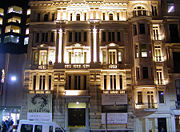
Istanbul Modern, located on the Bosphorus with a magnificent view of the Seraglio Point, resembles Tate Modern in many ways and frequently hosts the exhibitions of renowned Turkish and foreign artists. Pera Museum and Sakıp Sabancı Museum have hosted the exhibitions of world famous artists like Picasso, Rodin, Rembrandt and many others, and are among the most important private museums in the city. The Rahmi M. Koç Museum on the Golden Horn is an industrial museum, largely inspired by the Henry Ford Museum in the United States. It exhibits historic industrial equipment such as cars and locomotives from the 1800s and early 1900s, as well as boats, submarines, aircraft, and other similar vintage machines from past epochs.
Istanbul Archaeology Museum, established in 1881, is one of the largest and most famous museums of its kind in the world. The museum contains more than 1,000,000 archaeological pieces from the Mediterranean basin, the Balkans, the Middle East, North Africa and Central Asia. Istanbul Mosaic Museum contains the late Roman and early Byzantine floor mosaics and wall ornaments of the Great Palace of Constantinople. The nearby Turkish and Islamic Arts Museum, originally the Ibrahim Pasha Palace (1524) on Sultanahmet Square, displays a vast collection of items from various Islamic civilizations. Sadberk Hanım Museum on the Bosphorus contains a wide variety of artifacts, dating from the earliest Anatolian civilizations to the Ottomans.
Occasionally, in November, the Silahhane (Armory Hall) of Yıldız Palace hosts the Istanbul Antiques Fair, which brings together rare pieces of antiques from the Orient and Occident. The items are sold either directly, or through auction. The multi-storey Mecidiyeköy Antikacılar Çarşısı (Mecidiyeköy Antiques Bazaar) in the Mecidiyeköy quarter of Şişli is the largest antiques market in the city, while the Çukurcuma neighbourhood of Beyoğlu has rows of antiques shops in its streets. The Grand Bazaar, edificed between 1455–1461 by the order of Sultan Mehmed the Conqueror and later enlarged in the 16th century during the reign of Sultan Suleiman the Magnificent also has numerous antiques shops, along with shops selling jewels, carpets and other items of art and artisanship. Historic and rare books are found in the Sahaflar Çarşısı near Beyazıt Square, which was known as the Forum Tauri in the Roman period. It is one of the oldest book markets in the world, and has continuously been active in the same location since the late Roman, Byzantine and Ottoman periods.
A significant culture has been developed around what is known as a Turkish Bath ( Hamam), the origins of which can be traced back to the ancient Roman Bath, which was a part of the Byzantine lifestyle and customs that were inherited first by the Seljuk Turks and later the Ottomans, who developed it into something more elaborate. It was a culture of leisure during the Ottoman period. The hamams in the Ottoman culture started out as structural elements serving as annexes to mosques, however quickly evolved into institutions and eventually with the works of the great Ottoman architect Sinan, into monumental structural complexes, the finest example being the Çemberlitaş Hamamı (1584) in Istanbul, located on the Çemberlitaş (Column of Constantine) Square.
Live shows and concerts are hosted at a number of locations including historical sites such as the Hagia Irene, Rumeli Fortress, Yedikule Castle, the courtyard of Topkapı Palace, and Gülhane Park; as well as the Atatürk Cultural Centre, Cemal Reşit Rey Concert Hall and other open air and modern theatre halls. For those who enjoy night life, there are many night clubs, pubs, restaurants and taverns with live music. The night clubs, restaurants and bars increase in number and move to open air spaces in the summer. The areas around Istiklal Avenue and Nişantaşı offer all sorts of cafés, restaurants, pubs and clubs as well as art galleries, theaters and cinemas.
Recreation
The most popular places for swimming in the city are in Bakırköy, Küçükçekmece, Sarıyer and the Bosphorus. Outside the city are the Marmara Sea's Princes' Islands, Silivri and Tuzla; as well as Kilyos and Şile on the Black Sea.
The Princes' Islands (Prens Adaları) are a group of islands in the Marmara Sea, south of the quarters Kartal and Pendik. Pine and stone-pine wooden neoclassical and art nouveau-style Ottoman era summer mansions from the 19th and early 20th centuries, horse-drawn carriages (motor vehicles are not permitted) and seafood restaurants make them a popular destination. They can be reached by ferry boats or high-speed catamaran Seabus (Deniz otobüsü) from Eminönü and Bostancı. Of the nine islands, only five are settled.
Şile is a distant and well-known Turkish seaside resort on the Black Sea, 50 kilometres (31 mi) from Istanbul, where unspoiled white sand beaches can be found. Kilyos is a small calm seaside resort not far from the northern European entrance of the Bosphorus at the Black Sea. The place has good swimming possibilities and has become popular in the recent years among the inhabitants of Istanbul as a place for excursions. Kilyos offers a beach park with seafood restaurants and night clubs, being particularly active in the summer with many night parties and live concerts on the beach.
Shopping
| “ | If one had but a single glance to give the world, one should gaze on Istanbul. | ” |
|
— Alphonse de Lamartine |
||
Istanbul has numerous historic shopping centers, such as the Grand Bazaar (1461), Mahmutpaşa Bazaar (1462) and the Egyptian Bazaar (1660). The first modern shopping mall was Galleria Ataköy (1987), which was followed by dozens of others in the later decades, such as Akmerkez (1993) which is the only mall to win both "Europe's Best" and "World's Best" awards by the ICSC; Metrocity (2003); Cevahir Mall (2005) which is the largest mall in Europe; and Kanyon Mall (2006) which won the 2006 Cityscape Architectural Review Award for its interesting design. İstinye Park (2007) and City's Nişantaşı (2008) are two new malls which target high-end consumers and are almost exclusively dedicated to world-famous fashion brands.
Bars, cafés and restaurants
Along with the traditional Turkish restaurants, many European and Far Eastern restaurants and numerous other cuisines are also thriving in the city.
Most of the city's historic pubs and winehouses are located in the areas around İstiklal Avenue in Beyoğlu. The 19th century Çiçek Pasajı (literally Flower Passage in Turkish, or Cité de Péra in French, opened in 1876) on İstiklal Avenue can be described as a miniature version of the famous Galleria in Milan, Italy, and has rows of historic pubs, winehouses and restaurants. Pano, established by Panayot Papadopoulos in 1898, and the neighbouring Viktor Levi, established in 1914, are among the oldest winehouses in the city and are located on Hamalbaşı Avenue near the British Consulate and Galatasaray Square. Cumhuriyet Meyhanesi (literally Republic Winehouse), called this way since the early 1930s but originally established in the early 1890s, is another popular historic tavern and is located in the nearby Sahne Street, along with the Hazzopulo Winehouse, established in 1871, inside the Hazzopulo Pasajı which connects Sahne Street and Meşrutiyet Avenue. The famous Nevizade Street, which has rows of historic pubs next to each other, is also in this area.
Other historic pubs are found in the areas around Tünel Pasajı and the nearby Asmalımescit Street. Some historic neighbourhoods around İstiklal Avenue have recently been recreated, such as Cezayir Street near Galatasaray Lisesi, which became known as La Rue Française and has rows of francophone pubs, cafés and restaurants playing live French music.
Istanbul is also famous for its historic seafood restaurants. Many of them were originally established by the local Greeks, such as Aleko'nun Yeri in Yeniköy on the European side of the Bosphorus, or Koço Restaurant in the Moda neighbourhood on the Asian side of the city, which also has a small Greek Orthodox Chapel and Hagiasma (Holy Spring) inside. The most popular seafood restaurants are generally found along the shores of the Bosphorus and by the Marmara Sea shore towards the south of the city; from the south to the north Kumkapı, Ortaköy, Kuruçeşme (Park Fora, Marina), Arnavutköy (Kuyu), Bebek (Bebek Balıkçısı), Rumeli Hisarı (İskele), Yeniköy (İzmirli Balıkçı), Kireçburnu (historic Ali Baba) and Sarıyer on the European side; or Üsküdar, Kuzguncuk (İsmet Baba), Beylerbeyi (Villa Bosphorus), Kandilli, Anadolu Hisarı, Çengelköy (Deniz Yıldızı) on the Anatolian side. The Princes' Islands in the Sea of Marmara (Büyük Ada, Heybeli Ada, Kınalı Ada, Burgaz Ada) and Anadolu Kavağı near the northern entrance of the Bosphorus towards the Black Sea (close to Yoros Castle, which was also known as the Genoese Castle due to Genoa's possession of it in the mid-15th century) also have many historic seafood restaurants.
Clubs
There are thousands of alternatives for night life in Istanbul but the most popular open air summer time seaside night clubs are found on the Bosphorus, such as Reina, Sortie and Anjelique in the Ortaköy district. Babylon and Nu Pera in Beyoğlu are popular night clubs both in the summer and in the winter, while Istanbul Arena in Maslak frequently hosts the live concerts of famous singers and bands from all corners of the world. Parkorman in Maslak hosted the Isle of MTV Party in 2002 and is a popular venue for live concerts and rave parties in the summer. Q Jazz Bar in Ortaköy offers live jazz music in a stylish environment.
Education
Universities
Istanbul holds some of the finest institutions of higher education in Turkey, including more than 20 public and private universities. Most of the reputable universities are public, but in recent years there has also been an upsurge in the number of private universities. Istanbul University (1453) is the oldest Turkish educational institution in the city, while Istanbul Technical University (1773) is the world's second-oldest technical university dedicated entirely to engineering sciences. Other prominent state universities in Istanbul are the Boğaziçi University (1863), Mimar Sinan University of Fine Arts (1882), Marmara University (1883), Yıldız Technical University (1911) and Galatasaray University (1992). The major private universities in the city include Koç University (1993), Sabancı University (1994), Yeditepe University (1996), Bilgi University (1996), Işık University (1996), Fatih University (1996), Maltepe University (1997), Beykent University (1997), Kadir Has University (1997), Haliç University (1998), Bahçeşehir University (1998), Okan University (1999), and Istanbul Commerce University (2001).
High schools
Galatasaray Lisesi, established in 1481 as Galata Sarayı Enderun-u Hümayunu (Galata Palace Imperial School) and later known as Galatasaray Mekteb-i Sultanisi (Galatasaray School of the Sultans) is the oldest Turkish high school in Istanbul and the second oldest Turkish educational institution in the city after Istanbul University which was established in 1453. Galatasaray gives education primarily in Turkish and French, but there are also courses in English, Italian, Latin, Greek, Ottoman Turkish, Persian and Arabic.
İstanbul Lisesi, also commonly known as İstanbul Erkek Lisesi (established in 1884), abbreviated İEL, is one of the oldest and internationally renowned high schools of Turkey located in İstanbul. The school is considered among the elite of Turkish public high schools. Germany recognizes the school as a Deutsche Auslandsschule (German International school).
Almost all Turkish private high schools and universities in Istanbul teach in English, German or French as the primary foreign language, usually accompanied by a secondary foreign language.
Fen Liseleri (Science High Schools) were established with the aim of providing education to exceptionally gifted students in mathematics, physics, chemistry and other sciences. These are boarding schools which offer a three-year program with a curriculum that emphasises science and mathematics. The schools have a standard class size of 24 pupils and the language of instruction is Turkish.
Anadolu Liseleri (Anatolian High Schools) were originally furnished for the Turkish children who returned home from foreign countries, such as the Üsküdar Anadolu Lisesi with German as the primary foreign language and technical instruction in German. Kadıköy Anadolu Lisesi on the Asian side, however, is one of the first six special Ministry of Education Colleges (Maarif Koleji) established in 1950s in big cities across Turkey. Those English-medium colleges, too, were renamed as "Anadolu Lisesi" in subsequent decades.
There are many foreign high schools in Istanbul, most of which were established in the 19th century in order to give education to the foreigners residing in Istanbul, or to local Stambouliotes with European roots. Following the establishment of the Republic of Turkey, most of these schools went under the administration of the Turkish Ministry of Education, but some of them still have considerable foreign administration, such as the Liceo Italiano (Özel İtalyan Lisesi, 1861) which is still regarded as an Italian state school by the government of Italy and continues to receive funding and teachers from Rome. The oldest such school is the French Lycée Saint-Benoit, established in 1783 with its current name (the school's roots go back to 1362). Robert College, established in 1863, is the world's oldest American school outside the United States. The first international school in the city, Istanbul International Community School, was founded in 1911 to educate the children of international professors at Robert College. The name of the school was [[Robert College Community School until 1979, when it was changed to its current name, Istanbul International Community School (IICS). With a law passed by the Turkish Parliament in 1971, foreign universities in Turkey (i.e. Boğaziçi University which was originally the university section of Robert College) went under the jurisdiction of the Turkish state, but high schools were allowed to operate with foreign headmasters and curricula, such as the high school section of Robert College which continues to have an American headmaster. Other similar examples are the Lycée Notre Dame de Sion (1856), Deutsche Schule Istanbul (1868), Lycée Saint-Joseph (1870), Üsküdar American Academy (1876), Lycée Saint-Michel (1886), Sankt Georg Austrian High School (1892), Zappeion Greek Girls' High School, Italian Girls' Junior High School, Esayan Armenian Girls' High School, Saint Jean Baptiste French Boys' School, Saint Pulcherie Jesuit School, Zoğrafyon Greek Boys' High School and the British Girls' School. Phanar Greek Orthodox College (Fener Rum Erkek Lisesi), established in 1454, is the oldest surviving and most prestigious Greek high school in the city. Many Ottoman viziers as well as Wallachian and Moldavian princes appointed by the Ottoman state were graduated from this school.
Libraries
Istanbul has numerous libraries, many of which contain vast collections of historic documents from the Roman, Byzantine and Ottoman periods, as well as from other civilizations of the past. The most important libraries in terms of historic document collections include the Topkapı Palace Library, Library of the Archaeological Museum Archaeological Museum, Library of the Naval Museum, Beyazıt State Library, Nuruosmaniye Library, Süleymaniye Library, Istanbul University Library, Köprülüzade Fazıl Ahmed Paşa Library, Atatürk Library and Çelik Gülersoy Library.
Sports
During the Roman and Byzantine periods, the most important sporting events were the chariot races that were held at the Hippodrome of Constantinople, which had a capacity to accommodate more than 100,000 spectators.
Today, sports like football, basketball and volleyball are very popular in the city. In addition to Galatasaray, Fenerbahçe and Beşiktaş, which field teams in multiple sports, several other clubs have also excelled in particular team sports; such as Efes Pilsen and Fenerbahçe Ülker in basketball; or Eczacıbaşı and Vakıfbank in volleyball.
The Atatürk Olympic Stadium is a five-star UEFA stadium and a first-class venue for track and field, having reached the highest required standards set by the International Olympic Committee and sports federations such as the IAAF, FIFA and UEFA. The stadium hosted the 2005 UEFA Champions League Final. The Şükrü Saracoğlu Stadium will host the 2009 UEFA Cup Final.
Personal sports like golf, horse riding and tennis are gaining popularity as the city hosts international tournaments such as the WTA Istanbul Cup. For aerobics and bodybuilding, numerous fitness clubs are available. Paintball is a sport which has recently gained popularity and is practiced by two large clubs in the proximity of Istanbul. Martial arts and other Eastern disciplines and practices such as Aikido and Yoga can be exercised in several centers across the city. Istanbul also hosts the annual MTB races in the nearby Belgrad Forest and Büyükada Island. Two of the most prominent cycling teams of Turkey, namely the Scott/Marintek MTB Team and the Kron/Sektor Bikes/Efor Bisiklet MTB Team, are from Istanbul.
Istanbul hosts several annual motorsports events, such as the Formula One Turkish Grand Prix, the MotoGP Grand Prix of Turkey, the FIA World Touring Car Championship, the GP2 and the Le Mans Series 1,000 km (621 mi) races at the Istanbul Park GP Racing Circuit.
From time to time Istanbul also hosts the Turkish leg of the F1 Powerboat Racing on the Bosphorus. Several annual sailing and yacht races take place on the Bosphorus and the Sea of Marmara. The Golden Horn is where the rowing races take place. Major clubs like Galatasaray, Fenerbahçe and Beşiktaş, and major universities such as the Bosphorus University have rowing teams.
Air racing is new to the city. On July 29, 2006, Istanbul hosted the 4th round of the spectacular Red Bull Air Race World Series above the Golden Horn.
| Club | Sport | Established | League | Venue |
|---|---|---|---|---|
| Beşiktaş JK | Football | 1903 | Turkcell Super League | İnönü Stadium |
| Galatasaray SK | Football | 1905 | Turkcell Super League | Ali Sami Yen Stadium |
| Fenerbahçe SK | Football | 1907 | Turkcell Super League | Şükrü Saracoğlu Stadium |
| Istanbulspor AS | Football | 1926 | Turkish 2nd Division | Güngören Stadium |
| Beşiktaş Cola Turka | Basketball | 1903 | Turkish Basketball League | BJK Akatlar Arena |
| Galatasaray Cafe Crown | Basketball | 1905 | Turkish Basketball League | Ayhan Şahenk Sports Hall |
| Fenerbahçe Ülkerspor | Basketball | 1907 | Turkish Basketball League | Abdi İpekçi Arena |
| Beykoz 1908 | Basketball | 1908 | Turkish Basketball League | R. Şahin Köktürk Sports Hall |
| Darüşşafaka S.K. | Basketball | 1914 | Turkish Basketball League | Ayhan Şahenk Sports Hall |
| Tekelspor | Basketball | 1941 | Turkish Basketball League | Haldun Alagaş Sports Hall |
| Efes Pilsen S.K. | Basketball | 1976 | Turkish Basketball League | Abdi İpekçi Arena |
| Alpella | Basketball | 2006 | Turkish Basketball League | Caferağa Sports Hall |
| Eczacıbaşı | Volleyball | 1977 | Turkish Women's Volleyball League | Eczacıbaşı Sports Hall |
| Vakıfbank Güneş Sigorta | Volleyball | 1986 | Turkish Women's Volleyball League | Haldun Alagaş Sports Hall |
Town twinning
The following is a list of Istanbul's sister cities:
|
|
Related lists
- List of architectural structures in Istanbul
- List of columns and towers in Istanbul
- List of hospitals in Istanbul
- List of Istanbulites
- List of libraries in Istanbul
- List of mayors of Istanbul
- List of museums and monuments in Istanbul
- List of schools in Istanbul
- List of shopping malls in Istanbul
- List of urban centers in Istanbul
- List of universities in Istanbul
- List of tallest buildings in Istanbul



